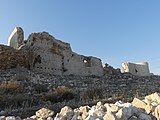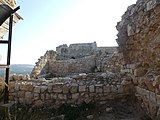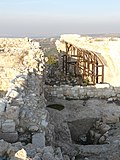Chamaa
Chamaa
شمع | |
|---|---|
Village | |
 | |
| Coordinates: 33°08′44″N 35°12′29″E / 33.14556°N 35.20806°E | |
| Grid position | 169/283 PAL |
| Country | |
| Governorate | South Governorate |
| District | Tyre District |
| Area | |
| • Total | 414 ha (1,023 acres) |
| Elevation | 380 m (1,250 ft) |
| Population (2015) | |
| • Total | 301 |
| [1] | |
| Time zone | EET |
Chamaa (
It is especially known for its historical castle on a strategic hill overlooking the coastal plain of Tyre and Naqoura.[3]
The United Nations Interim Force in Lebanon (UNIFIL) Sector West headquarters, led by the contingent of the Italian army, are based on a neighbouring hill.[4]
Name

According to E. H. Palmer, Kŭlảt Shemả, means the castle of Shemả; he suggested to link it with the Hebrew given name Shimeon.[5]
While the transliteration of the Arabic word for castle of would more precisely be Qala'at, it has also been spelled Kalat.[6]
Chamaa is also transliterated as Chama or Shama, and - more closely to the Arabic original pronunciation - Chama'a. It draws its name from a grave in a shrine on the main hill which is attributed by local tradition to
History
Ancient Times

The preserved remains of a Roman-Byzantine village at the close by archaeological site of Ermet Tell seem to support the local tradition which states that the hill was used as a mausoleum in the first century CE. Evidently, the hill was inhabited during the Byzantine rule over the Levant (395–640), as is obvious from a mosaic which has been discovered on the top of the hill.[3]
With regard to its strategic location near the
It is unclear what happened to the settlement in Chamaa after the area was conquered by the bearers of
The exact date of the construction of the Shamoun al-Safa shrine is unknown, but its minaret was reportedly built in the late 11th century, shortly before the arrival of the crusaders.[9]
Medieval Times

In 1116, during the aftermath of the First Crusade, a Frankish army constructed a fortress over the Byzantine site in order to block access to heavily fortified Tyre,[10] which was the last city in the region held by Islamic rulers. It was eventually taken over by the Christian warriors in 1124, after a siege of almost six months had led to the negotiatied surrender of Tyre by the Seljuk military leader Toghtekin.[11] The fortress of Chamaa, which was thus part of the Kingdom of Jerusalem, also became known as Scandelion Castle, named after the neighbouring coastal area of Iskandarounah which in turn was named after Alexander the Great.[10]
It is unclear whether Chamaa Castle was - like many of Tyre's buildings - damaged in the
Ottoman Times

Although the
While the French historian Ernest Renan assumed that major construction of the castle took place in the 16th century,[6] modern historiography assumes that it was not until the mid-18th century that Chamaa experienced a major revival. At that time, Sheikh Nasif al-Nassar of the Shiite Ali al-Saghir dynasty, which dominated Jabal Amel for altogether almost three centuries, established de facto autonomy over the area and the castle became the property of his family.[3] During this early period, the citadel underwent extensive renovation and was used for military and residential purposes.[8] It also included an olive press, whose foundations are still visible today.[3]
This boom period ended, however, already after three decades in 1781, when Al-Nassar was killed in a power-struggle with the Ottoman governor of Sidon, Ahmad Pasha al-Jazzar, who had the Shiite population decimated in brutal purges. Thus, the Shiite autonomy in Jabal Amel ended for a quarter century.[18] According to Arab sources, Jazzar Pasha had his senior commander Salim Pasha al-Kabir demolish Chamaa castle,[9] like many other fortifications of Al-Nassar as well.[19]
Barely a century later, in 1875, French
When the French
Modern Times

During the
During Israel's invasion in the July 2006 Lebanon War, 21 civilians from the village of Marwahin, mostly children, were killed just outside of Chamaa in an Israeli Navy strike followed by a helicopter attack on their convoy while they were attempting to evacuate under Israeli orders.[25] UNIFIL medical teams reportedly came under fire during their rescue mission.[26]
In another assault, the citadel of Chamaa was partly destroyed, including its main tower.[8] While the shrine of Shamoun was rehabilitated with support from the Sheikhdom of Qatar, the renovation of the castle began only in 2014, funded by the Italian government.[23]
In July 2007, a French UNIFIL soldier was killed near Chamaa when an unexploded ordnance from the 2006 war blew up as he was trying to clear it.[27]
It is not clear in which year UNIFIL established the Sector West HQ in Chamaa, about 10 kilometres north of the
The mayor of Chamaa municipality has been Abdel-Qader Safieddine.[8] Safieddine is also the most common name on the epitaphs of the cemetery next to the mausoleum of Shamoun Al Safa.
Gallery
The Shrine ("Maqam") of Shamoun Al Safa
-
Shiite cemetery at the entrance side, most epitaphs bear the family name "Safieddine"
-
View towards the Sea with the UNIFIL base in the background
-
View towards the North
-
Info sign
The Castle
-
Northwestern tower
-
Ruins of the northern flank
-
Entrance to the northwestern tower, looking North
-
Embrasures in the northwestern tower
-
The northwestern tower with the shrine's minaret (right)
-
One of the two southeastern towers
-
The two southeastern towers
-
Backside of one of the two southeastern towers
-
Embrasure in one of the two southeastern towers
-
Modern ruins inside the castle's courtyard
-
The northeastern side from below
-
The northeastern corner
-
More ruins at the northeastern side
-
Eastern side, looking southwards
-
Centre of the eastern side
-
Ruins in the northwestern part of the courtyard
-
Ruins in the northeastern part of the courtyard
-
Overgrown ruins of the southeasternmost tower
-
Embrasure in the northwestern tower
References
- ^ "Sham'a, Al Janub, Lebanon - Population and Demographics". Retrieved 8 April 2023.
- ^ Maguire, Suzanne; Majzoub, Maya (2016). Osseiran, Tarek (ed.). "TYRE CITY PROFILE" (PDF). reliefweb. UN HABITAT Lebanon. p. 14. Retrieved 26 March 2020.
- ^ a b c d Badawi, Ali Khalil (2018). TYRE (4th ed.). Beirut: Al-Athar Magazine. pp. 141–142.
- ^ "UNIFIL Head of Mission hosts LAF Commander". UNIFIL. 19 September 2019. Retrieved 26 March 2020.
- ^ Palmer, 1881, p. 51
- ^ a b c Lortet, Louis (1884). La Syrie d'aujourd'hui, voyages dans la Phénicie, le Liban et la Judée (1875-1880). Paris: Hachette. p. 147.
- ^ "Religious site in Lebanon attracts Shia Muslims". SHAFAQNA - Shia News Association. May 3, 2019. Retrieved 26 March 2020.
- ^ a b c d Zaatari, Mohammed (December 27, 2010). "Chamaa citadel's future in danger, warns mayor". The Daily Star. Retrieved 26 March 2020.
- ^ a b c Jaber, Kamel (2005). MEMORY OF THE SOUTH. Beirut: SOUTH FOR CONSTRUCTION. pp. 36–39.
- ^ ISBN 978-0-521-625661.
- )
- )
- ISBN 978-0195181111.
- ISBN 9781850437666.
- ISBN 9789953171050.
- ^ Hütteroth and Abdulfattah, 1977, p. 180
- ^ Note that Rhode, 1979, p. 6 Archived 2020-03-01 at the Wayback Machine writes that the register that Hütteroth and Abdulfattah studied was not from 1595/6, but from 1548/9
- ^ Gharbieh, Hussein M. (1996). Political awareness of the Shi'ites in Lebanon: the role of Sayyid 'Abd al-Husain Sharaf al-Din and Sayyid Musa al-Sadr (PDF) (Doctoral). Durham: Centre for Middle Eastern and Islamic Studies, University of Durham.
- ^ الأمين, حسن (2003). جبل عامل السيف والقلم (in Arabic). دار الأمير للثقافة والعلوم.
- ^ Guérin, 1880, pp. 128-129
- ^ Conder and Kitchener, 1881, SWP I, p. 151
- ^ Conder and Kitchener, 1881, SWP I, p. 190
- ^ a b Zaatari, Mohammed (December 12, 2014). "Chamaa citadel renovation project kicks off". The Daily Star. Retrieved 26 March 2020.
- ^ Blanford, Nicholas (November 25, 1997). "16 die in southern fighting, threatening new bloodshed". The Daily Star. Retrieved 26 March 2020.
- ^ Fisk, Robert (30 September 2006). "Marwahin, 15 July 2006: The anatomy of a massacre". INDEPENDENT. Retrieved 26 March 2020.
- ^ Peter Bouckaert; Houry, Nadim (2006). Fatal Strikes: Israel's Indiscriminate Attacks Against Civilians in Lebanon. Vol. 18. Human Rights Watch. p. 38.
- ^ "U.N. peacekeeper killed in Lebanon". Cedars Revolution. 26 July 2007. Retrieved 26 March 2020.
- ^ Pappalardo, Salvatore (19 March 2015). "Lebanon: interview with Brigadier General Stefano Del Col". DIFESA online. Retrieved 29 March 2020.
Bibliography
- Conder, C.R.; Kitchener, H.H. (1881). The Survey of Western Palestine: Memoirs of the Topography, Orography, Hydrography, and Archaeology. Vol. 1. London: Committee of the Palestine Exploration Fund.
- Guérin, V. (1880). Description Géographique Historique et Archéologique de la Palestine (in French). Vol. 3: Galilee, pt. 2. Paris: L'Imprimerie Nationale.
- Hütteroth, Wolf-Dieter; Abdulfattah, Kamal (1977). Historical Geography of Palestine, Transjordan and Southern Syria in the Late 16th Century. Erlanger Geographische Arbeiten, Sonderband 5. Erlangen, Germany: Vorstand der Fränkischen Geographischen Gesellschaft. ISBN 3-920405-41-2.
- Palmer, E.H. (1881). The Survey of Western Palestine: Arabic and English Name Lists Collected During the Survey by Lieutenants Conder and Kitchener, R. E. Transliterated and Explained by E.H. Palmer. Committee of the Palestine Exploration Fund.
- Rhode, H. (1979). Administration and Population of the Sancak of Safed in the Sixteenth Century (PhD). Columbia University. Archived from the original on 2020-03-01. Retrieved 2020-03-28.
External links
- Chamaa, Localiban
- Survey of Western Palestine, Map 3: IAA, Wikimedia commons



























